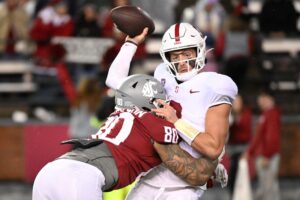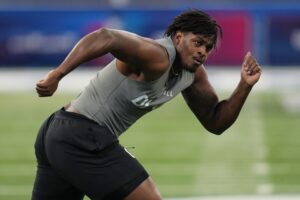The Kansas City Chiefs defensive woes are vastly understood and registered; there is no hiding inconsistency in a pass rush, rushing holes, and the deteriorating pass defense. Yes, Eric Berry is missing, Dee Ford has been up and down with injuries, and the interior linebackers are struggling to find a substantive rotation. Seeing and observing the defense is an easy task. However, denoting blame (a taboo topic) is another. From Bob Sutton running the ‘bend but not break’ method to Marcus Peters dancing opposed to tackling, there is plenty of blame to go around.
Yet, blame only does one thing; distract from fixing the solution. Sutton is running the same scheme he has run since 2013 and Peters has never tackled. The defense is little changed, save missing Berry and Derrick Johnson’s regression in speed and agility. Despite the hyperbole, there has not been substantive roster change to source the apparent sudden decline. The Chiefs defense is one built upon timing, precision, and fundamentals, all ideals built upon opportunity. While it may not have intrinsically regressed, it’s repeatedly getting exposed, demanding new players to step up.
How the Kansas City Chiefs Defense Can Reestablish Chaos
Statistical Standings at the Bye
Categorizing where the Chiefs defense stands against the NFL standard half way through the season is important to contextualizing performance. A certain expectation exists that the Chiefs defense be, at minimum, in the top half of the NFL. Since Andy Reid took over in 2013, the Chiefs defense has been the key to establishing temperament. While the offense postures as the more composed unit, adhering to a process of efficiency, the defense is postured as the aggressive and momentum turning unit.
When the Chiefs defense is discussed, one of the key notions to their success has been momentum changing plays. For a comparison model, the San Francisco 49ers followed the same tempo under Jim Harbaugh. Both utilized blitzes, veteran poise, and sure tackling to be among the best in turnover margin. Hence, a bit of luck in the bounce of the ball and fantastic fundamentals created chaos. One of the intrinsic problems, however, is that once players lose a step and begin to falter in assignments, the defense will regress.
Halfway through the season, the Chiefs rank 30th in rush yards allowed (1,180), 25th in rush touchdowns allowed (nine), 28th in pass yards allowed (2,333), and combining all yards allowed are 29th in the NFL (3,513). To cap off the numbers, they rank 15th in takeaways with 13 and allow 23.1 points per game, 19th in the NFL. Take that for data.
One of the statistical arguments for the defense has been the strength of schedule – taking on the New England Patriots, Philadelphia Eagles, Washington Redskins, Pittsburgh Steelers, Dallas Cowboys is no mere cakewalk. In some regards, the Chiefs are standing strong at 6-3. Yet, predicate that on the way the Chiefs defense has actually played, losing opportunity, and the way they ought to play to reach the highest level, and the strength of schedule argument is diminished.
Championship defenses play championship football, no excuses. To be marginally successful throughout the remainder of the season, the Chiefs defense ought to play more consistent. Meta statistics paint a troubling picture, but the micro statistics across the first nine games tell a bigger picture.
After shutting down Tom Brady in week one and the Eagles in week two, a troubling trend of explosive plays arose. The Los Angeles Chargers were held to ten points and committed three turnovers, but gave up concerning explosive plays to Melvin Gordon. The explosive play trends continued against the Washington Redskins and Kirk Cousins; with zero sacks, the Chiefs gave up four deep pass targets on six attempts.
Again, the Chiefs managed to win, but the Redskins seven penalties did a great service. Mentally, the defense was still forcing mistakes. Then comes Deshaun Watson, who proved the painful defensive trends. After a slow first-half, Watson spent the second half tossing the ball at will and creating explosive plays. The Steelers repeated it with Le’Veon Bell.
The problem is not the Chiefs defense being among the bottom with a brutal schedule, but the extrapolation of their core problems. Coordinators and coaches have found a way to schematically beat the Chiefs and impose their will. The problem is not a second-half schedule with one winning record team, but enduring the playoffs with a non-aggressive defense.
Concepts Behind Chaos
The Chiefs defense is based on a 3-4 scheme. Break down the front seven, and the egregious errors that have been punched will make more sense. However, the success of the past four seasons will also do so. To note, the 3-4 is just their base personnel; variations and subtleties that only the coaching staff know can and are introduced throughout the game.
The synthesis of the 3-4 assignment is the front seven putting weight toward the outside of the box by stacking three upfront defensive linemen with four linebackers, two of whom have outside assignment. The front three play a more linear form of football by eating and demanding double teams as their emphasis. The Chiefs run a modern version of the 3-4, where the down linemen will variably shoot gaps due to more flexibility in their play. However, the most emphatic player is the nose tackle (hence, why Dontari Poe was so important).
Why is the nose tackle emphatic to the defensive success? With only three down linemen, offensive linemen have focus on stretching downfield and sealing pursuing linebackers to unleash running backs. Thus, if the front three do not demand honor, then the entire scheme begins to crumble.
The meta notion for linebackers is two-fold. First, intangibles to recognize which gaps to attack to stop the offensive flow. Second, speed and agility to arrive at the gap in time. The outside backers also have a demand to align as pure pass rushers on passing downs. Hence, the outside backer must assert quick leverage, while the interior linebackers must carry forward momentum.
However, flexibility among the core is an additional demand. Due to various schemes of other teams, the outside four must be able to align to attack from inside shade, or outside shade. They ought to be able to assert leverage regardless of offensive front.
Combining everything, the duty of the front seven eases the Chiefs secondary unit responsibility. The secondary revolves around Berry, who guides the point of attack. The safeties play the compass of the field with responsibility to drop into coverage and assist in zone or engage in run pursuit.
The outside corners and slot have responsibility to take on one-on-one battles, meeting their target later in the route, and physically imposing their will by means of technicality. The pass rush meets the quarterback, and disrupts the entire process with the synthesis of creating chaos in all assignments.
Major Personnel
Take a step back from the meta-analysis for a moment, and start to find the major players who work within Sutton’s 3-4 scheme – those are the players that can turn the trend and reassert progressive aggressiveness.
The 3-4 defense should be noted, above all, a bend but not break defense. Not every play begets pressure or a double team freeing a linebacker (the break). However, the defense also tosses about quarterbacks and creates chaos more than a 4-3 (the not bending).
Thus, Justin Houston and Ford take the onus on passing downs. The two outside linebackers have the onus of asserting pressure and setting the edge on the run. By doing this, interior linebackers Derrick Johnson and Reggie Ragland have responsibility of blitzing on some downs, spying in cover one, or simply filling the gap.
Up front, Bennie Logan needs to play with a lateral speed to fill space, while Chris Jones and Allen Bailey play next to Logan to attack the passer and eat space respectively. However, this is also where the problems begin. Roy Miller, Rakeem Nunez-Roches, and Jarvis Jenkins are average lateral defensive linemen. Thus, on rotational downs and later in the game when more sub packages come in, the Chiefs lose the onus upfront.
Thus, Ragland or Ramik Wilson lose the ability to attack the gap, allowing offensive guards to key in on Johnson. The problem is not necessarily the starting talent, but the rotational packages in the second half. When onus is lost, and rotations come in for varying scheme fits, offenses have manipulated the Chiefs defense to settle into average alignment. Their weakest points are intrinsically revealed as the game goes on, contextualizing why second-half defense suffers.
Creating New Precision
Losing Berry was one of the biggest hits to the Chiefs defense. Not only did they lose their general, the Chiefs also lost a major aspect of speed. Daniel Sorensen is another example of a good rotational player, but a slower and less athletic safety who can be intrinsically exposed by manipulative schemes.
The onus then switches to Ron Parker, which is where new precision ought to begin. Parker as the free safety needs to play above his B level come playoff time. At times, he has been one of the most prolific attackers, other times, he loses integrity when flying to the zone. He does not have rotational speed to play backward, thus positions himself backward naturally. However, that hurts his ability to play upward, creating a bamboozled play style.
Instead, Parker needs to play with freedom. He is without Berry for the remainder of the season, and thus needs to play out of his mind. There is a hesitancy amidst his coverage demeanor; his most egregious mistakes are made when he does not play free. Worrying less about mistakes, and playing fundamental, relaxed football will aid him in attacking the compass and becoming the leader.
A long series of meetings between Parker and Sutton ought to aid the film study, and ease him into the general role throughout the remainder of the season. Thus, come playoff time he will be excelling. Sorensen is who Sorensen is; Parker has the talent to aid the corners.
Peters is another example of a corner being who he is. He will have great moments of coverage then burned next. He plays a technical game but does not always want to be so aggressive. He will out finesse most receivers, but will give up one or two explosive plays to equally technical receivers. Fortunately, of whom there are few.
The Chiefs are getting Tamba Hali back, an excellent addition to the outside attack, but Hali only bolsters the pass rush; his role in run and play identification is minimal. Ragland was acquired late in the process to bolster the run defense, and unfortunately, a lot of the success falls on his ability to become a real threat.
Wilson was a nice linebacker, but is better as a backup. He will get pushed around at times and miss certain gaps. Hence, why Ragland takes on prolific duty. If Ragland turns into a real threat, then guards must protect against Ragland and Johnson. Further, if the counter run rolls away from Johnson, then the middle linebackers are more prone to trip over each other if Ragland fails to recognize the correct gap.
Ragland’s onus begins with attacking the correct gap and becoming fearless. Thankfully, there is a fantastic opportunity for Ragland to grow into his role. Being only in his second year of play and coming back from injury, watching Ragland explode in the second half is very likely.
Lastly, the pass rush ought to improve, and demands thorough attack from more than just Houston. Houston has 7.5 sacks on the year, and while Ford has been injured, his play has been uninspired. The pass rush solutions epitomize the overall meta of where the Chiefs defense can improve: from Frank Zombo to rookie Tanoh Kpassagnon, when offenses manipulate scheme misalignments, if the pass rush and defense plays without regard for making mistakes and paralysis by analysis, chaos can be reasserted, and forcing turnovers can take onus once again.
Main Image:






